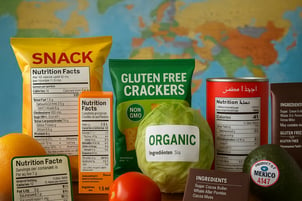A Guide to Cosmetics Regulations in Africa
The beauty market in the Middle East is absolutely booming. We are talking about a vibrant, fast-growing sector that's set to hit an incredible $32.2 billion by 2025. This isn't just about big numbers, it is fueled by consumers who care deeply about what they put on their skin. There's huge demand for natural products and a significant, growing interest in Halal-certified cosmetics (that means no pork-derived ingredients, for starters) and vegan products. The GCC halal cosmetics market is particularly gaining momentum, reflecting the region’s unique cultural and ethical priorities.
But here's the thing, getting your beauty brand into this exciting market isn't always straightforward. Each country has its own set of rules, and while there is a lot of alignment, navigating the nuances can feel a bit extra sometimes. This is where this guide comes in. We will cut through the complexity, lay out exactly what you need to know about compliance, and help you avoid costly missteps. Understanding these regulations is about building trust, getting legal access, and setting your business up for long-term success.
Why Regulatory Compliance is Non-negligible in the Middle East
Don't think of regulatory compliance in the Middle East as an obstacle, think of it as your vital passport to success. First and foremost, this is all about consumer safety and their trust in you. With consumers now looking for natural, Halal and vegan options, they expect a high level of quality and ingredient integrity. If you meet this expectation, then it clearly demonstrates that you are serious about what you are selling and builds loyalty, as well as protecting your brand's reputation.
In addition to trust, there is the incredibly real need for legal access to the market. Bypassing compliance can lead to potentially serious issues - we are talking banned products, hefty fines, costly recalls and a degraded reputation. Playing by the rules means that your products can flow through the market smoothly, without delay and untroubled by any compliance issues, allowing you to continue selling your product.
A solid compliance strategy will give you the opportunity for genuine growth. It creates clear import processes, expands distribution channels, and most importantly, provides a foundation to expand your brand with confidence across this exciting and fast-moving region. This is particularly true for brands aiming to capture a share of the GCC cosmetic market, where following proper procedures is the key to sustainable success.
Overview of the Middle East Regulatory Landscape: A Regional Perspective
The regulatory scene for cosmetics in the Middle East can seem a bit complicated at a glance. It is not a single rulebook for everyone, but rather a blend of national regulations. But the good news is that The Gulf Cooperation Council (GCC) has done a fantastic job of coordinating things. Countries like the UAE, Kuwait, Oman, Bahrain, and Saudi Arabia have largely mirrored their cosmetic laws after the EU Cosmetics Regulation 1223/2009, which many global brands are already familiar with.
At the core of GCC cosmetic rules are two vital standards: GSO 1943/2016, which covers everything about product safety, and GSO 2528/2016, which details claims you can make on your products. These GSO standards set the baseline for ingredients, labeling, and overall product quality across the GCC. Here's the key takeaway: while these "regulatory standards apply across the United Arab Emirates, Kuwait, Oman, Bahrain, and Saudi Arabia," remember that "each country has its own regulatory authority and requires a separate notification for each product." So, while the safety and claims rules are generally the same, the actual process of getting your product approved will vary from country to country. And outside the GCC, places like Egypt, Jordan, and Lebanon also have their specific national regulations, often drawing from similar international best practices.
Key Regulatory Authorities & Their Roles
So, who's actually setting and enforcing these rules? While the GCC works to harmonize standards, each country still has its own specific bodies handling product approvals and market surveillance. Knowing who’s who is half the battle:
GCC Standardization Organization (GSO)
The Unifying Force Think of the GSO as the architect behind the main rulebook. They develop the core standards that most GCC countries adopt. For cosmetics, this primarily means GSO 1943/2016 (safety) and GSO 2528/2016 (claims). If your product meets these, you're already on solid ground for the region.
United Arab Emirates (UAE)
A Key Hub The UAE is a massive entry point for many brands. Here, authorities like the Ministry of Industry and Advanced Technology (MOIAT) and Dubai Municipality handle most cosmetic product registrations and conformity checks. While they follow GSO standards, you'll still need to go through their specific product registration processes for each item.
Kingdom of Saudi Arabia (KSA)
A Major Market with Specifics Saudi Arabia is another huge market, and its Saudi Food & Drug Authority (SFDA) is the sole regulator for cosmetics. They have a detailed electronic notification system (like their "Jeem" system) and are very strict about product registration, Arabic labeling, and requiring a local authorized representative. The SFDA also follows GSO standards, but their enforcement is quite rigorous.
Egypt
Egypt's cosmetic landscape is primarily governed by the Egyptian Drug Authority (EDA). The EDA, operating under Law No. 151 of 2019, is responsible for ensuring the safety and quality of cosmetics through inspection and analysis, aligning with international standards. Products generally require registration and approval through a detailed process that includes submitting documents, undergoing compliance checks for ingredients and safety, and adhering to specific labelling and packaging requirements. The EDA has streamlined this with the EgyCosm electronic platform, aiming to automate procedures and create a standardized database. While some EDA-approved imports might be exempt from certain decrees, other perfumery products may still need a Certificate of Inspection (CoI) for customs. Arabic labelling is required for home-use products, with English acceptable for professional use.
Jordan
Jordan's cosmetic regulations are overseen by the Jordan Food and Drug Administration (JFDA), a national authority under the Ministry of Health. For any cosmetic product, a product registration and notification process with the JFDA is mandatory, often involving an application, document submission, and potential sample testing. Manufacturers without a local presence in Jordan will typically need to appoint a local authorized representative to manage the registration. Key documentation usually includes certificates of conformity (like CE or FDA), declarations of conformity, ISO certificates, free sales certificates, and details on composition, shelf-life, and stability. While English is accepted for official documents, Arabic labelling is often a practical necessity for market acceptance. The JFDA also utilises an electronic system to facilitate these registrations, emphasising a rigorous, multi-step import and approval process that includes customs clearance, inspection, and testing.
Lebanon
In Lebanon, the Ministry of Public Health (MOH) primarily regulates cosmetic products, collaborating with other entities like the Ministry of Economy and Trade. Companies distributing cosmetics must be registered with the MOH to supply certified materials, highlighting a focus on quality control. While a universal pre-market approval system might not be as explicit as in some neighboring countries, ensuring proper authorization to distribute is vital. The MOH is actively working to combat low-quality and counterfeit products, particularly in the growing aesthetic industry, emphasizing the use of original and certified materials. Cosmetic shipments can face specific import restrictions, such as weight and piece limits, often necessitating a formal permit from the Ministry of Health for exceeding these thresholds. Cosmetics are subject to customs duties and VAT, and regulated products require MOH permit approval for customs clearance, underscoring the need for careful adherence to their evolving framework.
Core Regulatory Requirements for Cosmetics
This is where the rubber meets the road. Getting your product ready for the Middle East means a comprehensive check-up by what's often called the 'Responsible Person' (which could be your local distributor or a specialized consultant). This role is vital for ensuring your product ticks all the boxes for safety and compliance.
Product Definition & How It's Classified
First off, is your product really a cosmetic, or does it cross into therapeutic territory? Just like in other markets, products claiming to treat acne or offer strong UV protection might be seen as therapeutics, leading to a completely different (and much stricter) regulatory pathway. Clear, non-medicinal claims are key.
The Responsible Person’s Comprehensive Review
Before your product hits the shelves, the Responsible Person undertakes a thorough review process. This isn't just a quick glance; it's a deep dive:
-
Formula Review: They meticulously analyze your product's ingredient list. The goal? To make sure every single ingredient and combination meets the restrictions and prohibitions set by GSO 1943/2016. This is also where the crucial checks for Halal and vegan compliance happen, ensuring no prohibited substances are present.
-
Label and Claim Review: Next, they scrutinize your product’s label and all its claims. This means making sure all necessary information (like symbols and warnings) is there, and that any marketing claims are evaluated according to GSO 2528/2016. Simply put, what you say about your product must be factual, not misleading, and backed by scientific evidence.
Ingredient Compliance
Beyond the formula review, you'll need to pay close attention to specific lists. There are "positive lists" (what's allowed) and "negative lists" (what's prohibited or restricted), all guided by GSO Annexes. And yes, the Halal and vegan considerations are a big deal here - ensuring ingredients meet religious and ethical standards is crucial for consumer acceptance across the GCC halal cosmetics market.
Labelling Requirements
Clear, accurate labeling is non-negotiable. Arabic is mandatory (alongside English), and your label must include: the product name, brand, manufacturer/distributor details, full ingredient list (INCI), net content, batch number, expiry date, instructions for use, and any necessary warnings. Your claims must be substantiated and never suggest a therapeutic benefit.
Special Considerations & Emerging Trends
The Middle East cosmetics market is constantly evolving, and a few key trends are shaping the future:
-
The Rise of Halal Certification: This is huge. While not always a mandatory legal requirement for market entry (depending on the country and product), getting Halal certification provides a significant competitive edge and builds immense trust with consumers. It assures them that your product adheres to Islamic principles from ingredients to production. This is often integrated directly into the formula review process.
-
"Clean Beauty," Natural & Vegan Products: The demand for "clean beauty" – formulas free from parabens, sulfates, phthalates, and synthetic fragrances – is strong and growing. Consumers are actively seeking natural and vegan options, creating a powerful market pull. However, simply using these buzzwords isn't enough; you need to genuinely substantiate any "green" or "clean" claims to avoid "greenwashing" accusations.
-
E-commerce Regulations: As online shopping explodes across the region, authorities are increasingly focusing on regulations for e-commerce, direct-to-consumer sales, and digital advertising. Brands need to ensure their online presence and claims also meet local compliance standards.
-
Staying Ahead of the Curve: The regulatory landscape in the Middle East is dynamic. New restrictions or updated guidelines can emerge. Brands that prioritize staying informed and are agile enough to adapt to these changes will be best positioned for long-term success.3Final Thoughts
Breaking into the Middle East's dynamic beauty market might seem a bit complicated at first. But honestly, once you get a handle on those crucial GSO standards and understand the vital role a Responsible Person plays, the path becomes much clearer. It really boils down to being proactive and thorough, not just to meet legal requirements, but to truly earn the trust of consumers who care deeply about product integrity, whether it is for natural ingredients or Halal certification. Think of compliance as an investment in your brand's future here. By getting it right, you are not just avoiding headaches, you are actively setting yourself up for real, lasting success in one of the world's most exciting and rapidly growing beauty landscapes — the GCC cosmetic market!
Tags:
Jul 22, 2025 4:50:25 PM







